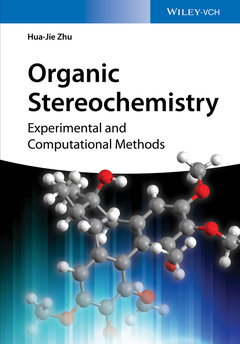Description
Organic Stereochemistry
Experimental and Computational Methods
Author: Zhu Hua-Jie
Language: English
Subject for Organic Stereochemistry:
334 p. · 17.5x25.2 cm · Hardback
Description
/li>Contents
/li>Biography
/li>
The text is clearly divided into three sections on fundamentals, spectroscopic and computational techniques, and applications in organic synthesis. The first part provides a brief introduction to the field of chirality and stereochemistry, while the second part covers the different methodologies, such as optical rotation, electronic circular dichroism, vibrational circular dicroism, and Raman spectroscopy. The third section then goes on to describe selective examples in organic synthesis, classified by reaction type, i.e. enantioselective, chemoselective and stereoselective reactions. A final chapter on total synthesis of natural products rounds off the book.
A valuable reference for researchers in academia and industry working in the field of organic synthesis, computational chemistry, spectroscopy or medicinal chemistry.
Preface IX
Acknowledgments XI
List of Abbreviations XIII
Part I Fundamentals 1
1 Chirality 3
1.1 Introduction 3
1.2 Tetrahedron of Carbon 9
1.2.1 Terpenoids 9
1.2.2 Flavonoids 13
1.2.3 Alkaloids 14
1.2.4 Steroids 16
1.2.5 Glycosides 17
1.2.6 Others 18
1.3 Other Stereogenic Centers 19
1.4 Optical Characteristics 23
1.4.1 Measurement of OR 24
1.4.2 ECD and Its Definition 25
1.4.3 Outline of VCD 26
1.4.4 Outline of ROA 27
References 28
2 Non-optical Method in Configuration Study 31
2.1 13CNMR Spectra 31
2.1.1 NMR and Atomic Structure 31
2.1.2 13C NMR Calculation 32
2.1.3 1HNMR 34
2.1.4 13C NMR Prediction and Conformational Search 34
2.2 X-Ray Diffraction and Mosher Method 41
2.2.1 X-Ray Diffraction 41
2.2.2 Mosher Method 44
2.3 Transition State Energy and Chirality Selectivity 51
2.4 Separation of Chiral Compounds 53
2.4.1 Chiral Organic Bases 53
2.4.2 Chiral Organic Acids 53
2.4.3 Chiral Organic Alcohols 53
2.4.4 Others 54
References 55
Part II Techniques 57
3 Optical Rotation (Rotatory Dispersion, ORD) 59
3.1 Introduction 59
3.2 Quantum Theory 59
3.3 Matrix Model 63
3.3.1 Matrix Basis 65
3.3.2 Explanation of General OR Characteristics 68
3.3.2.1 Sample Calculations 68
3.3.2.2 Calculated Values in Same Series of Compounds 73
3.4 ORD 77
3.5 Application 77
3.5.1 AC Assignment for Mono-Stereogenic Center Compounds 79
3.5.2 Matrix Model Application 80
3.5.3 AC Assignment for Poly-Stereogenic Center Compounds 82
3.5.4 Using ORD Method 83
References 84
4 Electronic Circular Dichroism 87
4.1 Exciton Chirality CD 87
4.2 ECD Characteristics for Chiral Metallic Compounds 92
4.3 Quantum Theory Basis 94
4.4 Principle Using ECD 95
4.5 Application 97
4.5.1 Procedure to Do ECD 97
4.5.2 ECD Application 97
4.5.3 UV Correction 102
References 105
5 Vibrational Circular Dichroism and Raman Optical Activity 107
5.1 Exciton Chirality 108
5.2 Quantum Theory Basis 109
5.2.1 VCD and IR 109
5.2.2 ROA and Raman Scattering 110
5.3 Principles Using VCD and ROA 113
5.4 Application 115
5.4.1 VCD Application 115
5.4.2 ROA Application 124
References 126
6 Combinational Use of Different Methods 129
6.1 Tactics to Select Methods 129
6.1.1 13CNMRMethods 130
6.1.2 OR and ORD 131
6.1.3 Matrix 132
6.1.4 ECD 132
6.1.5 VCD Method 133
6.2 Examples and Discussion 133
6.3 Revised Structures 138
6.3.1 ORD Method 139
6.3.2 Combinational Use of OR and ECD 144
6.3.3 VCD and ECD 146
6.3.4 Comprehensive Use of OR, ECD, and VCD 147
References 160
Part III Reactions 163
7 Enantioselective Reaction 165
7.1 Enantioselective Addition 165
7.1.1 Organic Zn- or Zn-Ti Reagent 165
7.1.2 Organic Cu–Zn, Cu–Li Reagent 169
7.1.3 Organo-Fe Complexes 173
7.1.4 Other Organo-Metallic Complexes 175
7.1.5 Organo-Si Reagents 178
7.2 Enantioselective Reduction 178
7.2.1 Green Chemistry 181
7.3 Enantioselective Oxidation 184
7.4 Prediction of ee Using Calculations 185
7.5 Catalyst Types 189
7.5.1 Amino Alcohols 189
7.5.2 Chiral Ligands Containing N–O Group 190
7.5.3 Chiral Axial Catalysts 191
7.5.4 Solid-Supported Chiral Compounds 192
7.5.5 Spiral Chiral Compounds 193
7.5.6 Asymmetric-Axle-Supported Chiral Catalyst 194
7.5.7 Chiral Shiff-Base Ligands 195
7.5.8 Some Asymmetric Lewis Acids 196
7.5.9 Organic P-Containing Ligands 197
7.6 Three Phenomena 198
7.6.1 Chirality Amplification (Nonlinear Effect) 198
7.6.2 Auto-Self Catalysis 199
7.6.3 Odd–Even Carbon Effect 199
References 201
8 Chemoselective Reaction 205
8.1 Chemoselective Additions 205
8.1.1 Addition to C=O or C=C Groups 205
8.2 Chemoselective Reduction 210
8.3 Chemoselective Oxidation 225
8.4 Other Chemoselective Reactions 231
References 237
9 Stereoselective Reaction 241
9.1 Conformational Study 241
9.2 Effect of Conformation on Reactions 247
9.3 Regioselective Reactions 251
9.4 Diastereoselective Reactions 260
9.4.1 Diastereoselective Additions 260
9.4.2 Other Diastereoselective Reactions 270
9.5 Calculation Using Theoretical Protocol 272
References 277
10 Total Organic Synthesis 279
10.1 Introduction 279
10.2 Retrosynthesis Strategies 279
10.3 Examples in Synthesis 285
10.3.1 (+)-Hirsutene 285
10.3.2 (2R,3S)-Rubiginone A2 and Its Analog 287
10.3.3 (+)-Brefeldin A 290
10.3.4 Malyngamide U and Its AC Reassignment 292
10.3.5 Taxol Derivatives 296
10.3.6 Amphidinolide T2 and Its Derivatives 298
10.3.7 (+)-Vindoline 303
10.4 Calculation in Total Synthesis 306
References 309
Index 313




